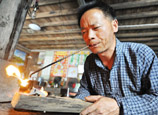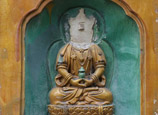
Daming Palace National Heritage Park
Since the construction in 8th year of the Zhenguan Period, especially when Emperor Gaozong moved in, the Daming Palace had been the ruling center for the Tang Dynasty for more than 200 years. The palace complex covered an area of 3.2 square kilometers and was four times the area of the Forbidden City in Beijing. It was the most grandiose palace building complex not only in the Tang capital city Chang’an but also in the world history of palace construction. On the original site of the palace, Daming Palace National Heritage Park has been built and was officially opened to the public on October 1, 2010. It is now protected as a key national heritage site by the government and has become a key point to pass on the ancient capital’s culture and civilization in urban Xi’an development.
Zhaoling Mausoleum Zhaoling Museum
Zhaoling Mausoleum in Liquan County Xianyang City is the joint tomb of Li Shimin, the second emperor of the Tang Dynasty and Empress Zhangsun. It is a typical imperial tomb of the Tang Dynasty and believed to be the biggest imperial mausoleum with the largest numbers of satellite tombs in China. Zhaoling Museum is a key cultural site under state protection and is recognized as a national AAA-level scenic area. The museum mainly displays a variety of inscribed stone tablets and epitaphs unearthed from Zhaoling Mausoleum. The museum is noted as “Zhaoling Forest of Stone Tablet” in that these steles were of unique value to the study of Chinese history, culture and calligraphy. The valuable treasure enables research and further understanding into the politics, economy and culture of the Tang Dynasty, even the Chinese feudal society.
Qianling Mausoleum Qianling Museum
Qianling Mausoleum, located in Qianxian County Xianyang City, is the joint tomb in Chinese history where the only women Emperor Wu Zetian and her husband Emperor Gaozong of the Tang were buried. It is believed to be the only imperial tombs among the 18 imperial mausoleums of the Tang Dynasty which had not been disturbed. There are 17 satellite tombs around. Qianling Museum is built in the compound of the Tomb of Princess Yongtai. The museum is now a key heritage site under state protection and has been developed into a national AAAA-class tourist attraction. The tri-colored glazed pottery, mural paintings and the linear carvings on the outer coffin are regarded as the three incomparable relics of the museum which visitors must never miss.
Huaqing Palace Heritage Site
As a key national heritage site under state protection, the Huaqing Palace Heritage Site is one of the few AAAAA-class tourist attractions in Xi’an not only for its old history but also for its natural beauty. Because of the hot springs here, the site had been a winter resort for emperors and their concubines of different dynasties in ancient China. In the Tang Dynasty, Emperor Xuanzong had the Huaqing Palace built on the site of the old palaces for him and his favorite concubine Yang Yuhuan where they had the romance the world is still lamenting today. A stream of pleasing, natural, slick and pure hot spring flows across the palace making people yearn for. The site has been enjoying equal popularity as the “Oriental Holy Spring” with Thermar of Caracalla in ancient Rome and Bath hot spring in England. Enjoying the beautiful scenery of Mount Lishan, bathing in the comfortable hot spring, watching the Song of Eternal Sorrow, you will be intoxicated in the gentle and romance between Emperor Xuanzong and his Concubine Yang as if taken back to the days of the prosperous Tang Dynasty.
Dayan Pagoda
As a key cultural heritage site under state protection and a national AAAAA-class tourist attraction, Dayan Pagoda is acclaimed as a masterpiece of Buddhist architecture in China. Externally the brick pagoda looks like a square cone, simple but grand. One can climb through the seven flights of winding wooden stairs up to the 64-meter high top to appreciate the panoramic view of the ancient city in distance from the arch-shaped doors on four sides of each story.
Famen Temple
Located in Famen Town 10 kilometers north of Fufeng County Baoji City, Famen Temple is renowned as the holy place of Buddhism for preserving the finger bone relics of Sakyamuni, founder of Buddhism. Initially established at the end of the Eastern Han Dynasty with more than 1700 years history, the temple is taken as “the Grandfather of Temples and Pagodas in Central China.” As an imperial temple in the Tang Dynasty, Famen Temple had observed seven grand worshiping ceremonies of the Buddhist relics, exerting profound influence on Buddhism and politics of the Tang Dynasty.
















 Man commits suicide, rescued by his wife in NE China
Man commits suicide, rescued by his wife in NE China


![]()
